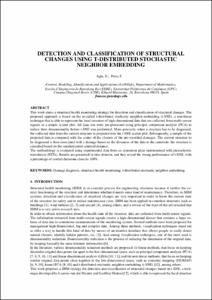Detection and classification of structural changes using t-distributed stochastic neighbor embedding

Visualitza/Obre
Estadístiques de LA Referencia / Recolecta
Inclou dades d'ús des de 2022
Cita com:
hdl:2117/169560
Tipus de documentText en actes de congrés
Data publicació2019
Condicions d'accésAccés obert
Llevat que s'hi indiqui el contrari, els
continguts d'aquesta obra estan subjectes a la llicència de Creative Commons
:
Reconeixement-NoComercial-SenseObraDerivada 3.0 Espanya
Abstract
This work states a structural health monitoring strategy for detection and classification of structural changes. The proposed approach is based on the so-called t-distributed stochastic neighbor embedding (t-SNE), a non-linear technique that is able to represent the local structure of high-dimensional data that are collected from multi-sensor signals in a simple scatter plot. All data sets were pre-processed using principal component analysis (PCA) to reduce their dimensionality before t-SNE was performed. More precisely, when a structure has to be diagnosed, the collected data from the current structure is projected into the t-SNE scatter plot. Subsequently, a sample of the projected data is compared with the center of the clusters of the pre-recorded damages. The current structure to be diagnosed is then associated with a damage based on the distances of the data to the centroids: the structure is classified based on the smallest point-centroid distance.
The methodology is evaluated using experimental data from an aluminum plate instrumented with piezoelectric transducers (PZTs). Results are presented in time domain, and they reveal the strong performance of t-SNE, with a percentage of correct decisions close to 100%.
CitacióAgis, D.; Pozo, F. Detection and classification of structural changes using t-distributed stochastic neighbor embedding. A: International Conference on Structural Engineering Dynamics. "Proceedings of the International Conference on Structural Engineering Dynamics". 2019, p. 1-10.
ISBN978-989-99424-7-9
| Fitxers | Descripció | Mida | Format | Visualitza |
|---|---|---|---|---|
| 022_Pozo.pdf | Contribució del congrés | 519,6Kb | Visualitza/Obre |


